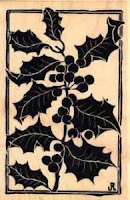Ever wonder why Decembers are typically filled
with evergreen swags and holly wreaths with bright red berries? The color red
was revered as the color against evil and the evergreen quality was believed to
keep evil spirits away during the dark part of the year. Red rosehips, red mountain ash, red haws of
hawthorns and particularly red holly berries, have long been hung around house doors
and windows and on barns and livestock fences to keep people and animals safe.
Holly, plant of power, was thought to ward off
the evil eye and to provide protection during the dark of the year. Ancient Romans
associated holly with Saturn, their god of time, justice and strength and gifts of holly were given during Saturnalia. In the
first century C.E., Pliny the Elder, author, naturalist, and natural
philosopher, wrote that Holly planted by the house kept away witchcraft.
Celtic people used the fresh, evergreen, undying holly leaves and branches to adorn their homes during the Winter
solstice and to crown their Celtic chieftains. They believed that fairies would take shelter in the evergreen
branches and bring good luck because of the hospitality.
Holly’s protection was also adopted by the early Christian
church. Holly was known as holy tree or Christ thorn,
while the name, holly, comes from the Old English holm or holen. Prickly holly
with its red berries like drops of blood commemorated Christ’s Crown of Thorns. Other legends told that the berries had
been white before Christ’s blood stained them red, or that the Cross was made
of wood from the holly. Another Christian parable told how holly miraculously grew leaves in order
to hide the Holy Family from Herod’s soldiers, and afterward it became evergreen in gratitude.
In medieval times, holly was used medicinally for ailments
including arthritis, kidney stones and bronchitis, and was calming for meditation. Holly’s apotropaic power was
used to preserve children from whooping cough if they drank milk out of a cup
carved from the close-grained white holly wood, and holly joined with bittersweet cured “hag-ridden’
horses and stopped their abuse by pixies, elves and little folk.
As late as 1640 John Parkinson wrote about holly in
his Theatrum Botanicum that ‘the
branches with berries are used at Christmas-tide to decke our houses withall,
but that they should defend the house from lightning and keepe themselves from
witchcraft. . . .’
In the twenty-first century, keep the traditions
alive while beautifying your landscape with Christmas Jewel® Holly PP14477,
renowned for large, brilliant red berries and glossy foliage. Plant several Christmas Jewel(R) shrubs in
order to have plenty of berried holly boughs to cut for treasured winter
decorations for years to come.
http://www.gardendebut.com/christmas-jewel-holly.php
Lore adapted from The Englishman's Flora, Geoffrey Grigson, J.M. Dent and Sons, Ltd., 1953, London.
Lore adapted from The Englishman's Flora, Geoffrey Grigson, J.M. Dent and Sons, Ltd., 1953, London.



































